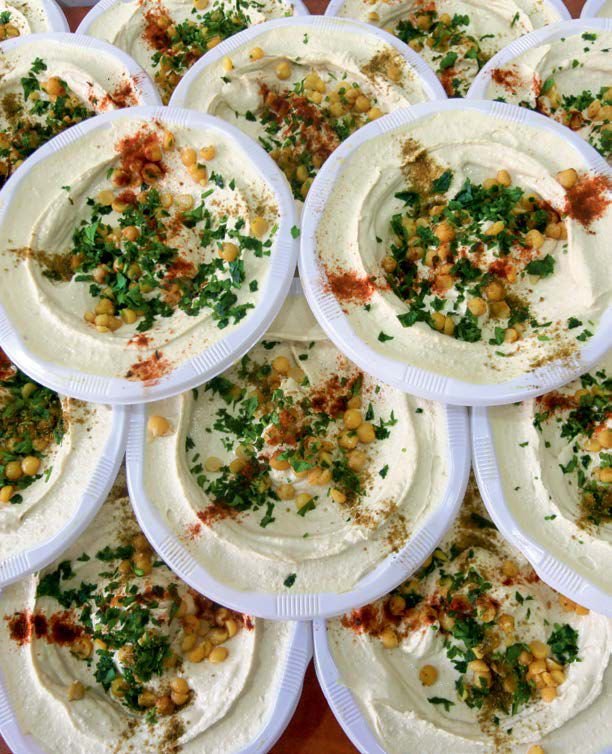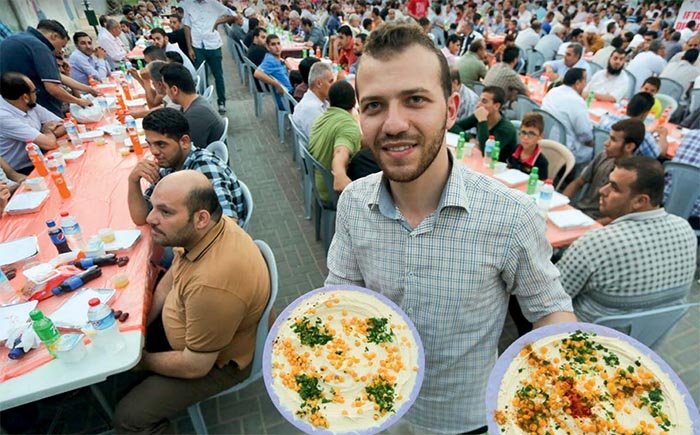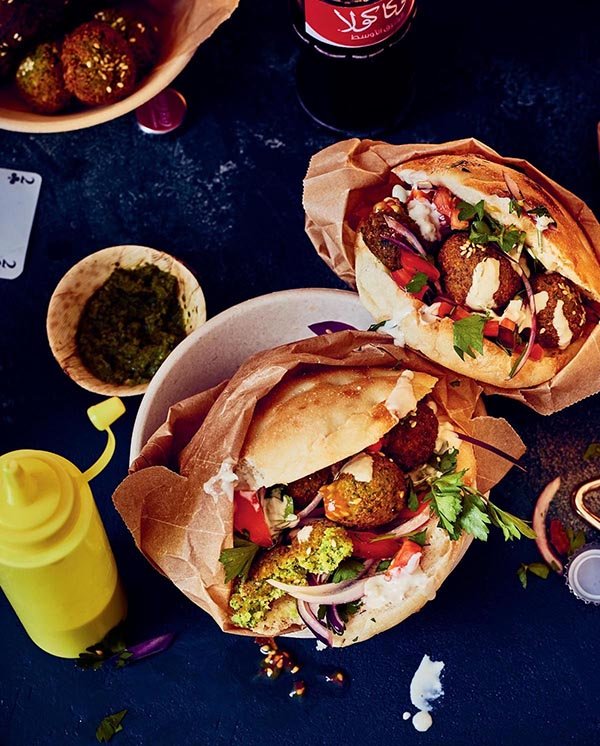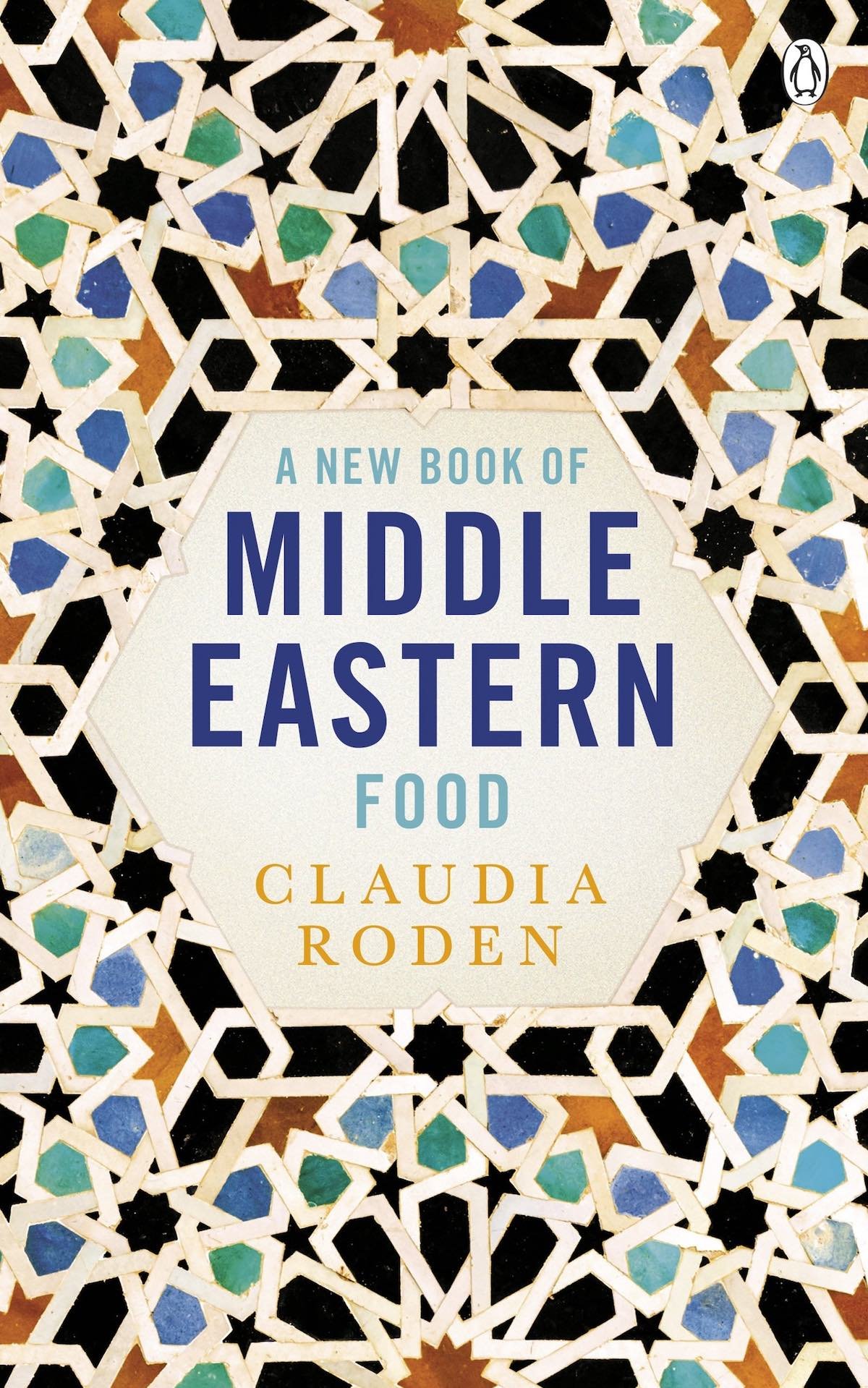Advertisement
Consuming passions: hummus
18 October 2022 · Consuming passions

Hummus, the Arabic and Hebrew word for chickpea, but more familiar as what food historian Alan Davidson calls the “ubiquitous paste,” comes into focus in a very special new addition to the ckbk bookshelf, On The Hummus Route.
Ariel Rosenthal, Dan Alexander, and Orly Peli-Bronshtein’s book brings together recipes and musings from more than 30 contributors of different backgrounds in a boundary-crossing celebration of the ancient pulse and dish. In the words of British-Palestinian chef Joudie Kalla, “It isn’t just a dip, it is the king of pulses, reigning over all else,” and “a symbol of the Middle East.”
The book leads us through nine Middle-Eastern hummus hubs, from Cairo all the way to Damascus, through Gaza, Jaffa, Tel Aviv, Jerusalem, Nazareth, Acre, and Beirut.
Here we take our own hummus route through ckbk’s titles exploring the significance (and deliciousness!) of this dish.
On the pulse
In On The Hummus Route, historian Dr. On Barak of Tel Aviv University describes how chickpeas were found left as offerings in ancient Egyptian archaeological sites. Dr. On Barak goes on to reflect on how he and the falafel “relocated to Europe more or less simultaneously: I, to begin an academic career in the study of Middle Eastern history; the falafel, to start a spicier career as an authentic Middle Eastern health food.”
Like the falafel, the chickpea itself has evolved from ancient pulse to modern wholesome ingredient.

Fresh chickpeas in the pod (photo from On The Hummus Route).
Falafels, hummus, chickpeas and what the book describes as “miracle water” (aquafaba, the chickpea liquid used to make vegan ‘meringue’) are now staples in Western kitchens, elevated to an almost curative, restorative status – as in the title of Melissa Delport’s book Whole: Bowl Food For Balance, which is all about healing your relationship with food. Delport writes, “You will never find my fridge without hummus in it.” Amen.
There are, of course, as many hummus recipes as there are ckbk chefs, but whether you plump for soaking dried chickpeas as Jane Grigson insists or à la Stéphane Reynaud’s quick version with tinned chickpeas, the basic recipe is essentially chickpeas, tahini, garlic, olive oil, and lemon, occasionally with a few other additions.
Tell me how you eat your hummus
Lebanon, Palestine, Israel, and Syria all claim hummus as their own, but it is difficult to pinpoint its exact origin. For some, hummus has become a symbol of resistance in Palestine.
In a chapter of The Hummus Route entitled ‘Tell me how you eat your hummus and I will tell you who you are,’ Prof. Liora Gvion, lecturer at Kibbutzim College of Education in Tel Aviv, describes how she will only eat it in an “Arab-owned” hummusiya (a simple restaurant specializing in hummus). The sense of identity linked to hummus is incredibly significant. Serving hummus in a Jewish kitchen becomes for Gvion a way of “obliterating a Palestinian culinary culture by monopolizing the food that has come to stand for Palestinian cuisine.”

Hummus served at an event in Gaza, from On The Hummus Route.
Another contributor to the book, Palestinian journalist and musician Mousa Tawfiq, writes that “his mother and most of her friends, who lived in refugee camps, believe that hummus and falafel are an indispensable part of our heritage and history. Therefore, having these dishes on the table every Friday is the least they can do to remind their children of their roots.”
Yotam Ottolenghi has frequently written about the emotive power of hummus, its factions, and its power to unite. In Plenty, which is now available as an à la carte title on ckbk, Ottolenghi tells us that Abu Hassan restaurant in Jaffa, Israel, boasts an “endless queue of Arabs and Jews standing at the door around lunchtime,” and that it is “the best hummus in the world.”
In Jerusalem (also available à la carte), a seminal book that explores the flavors of Ottolenghi and co-author Sami Tamimi’s childhood, their Basic Hummus is “super-smooth and rich in tahini, just as we like it.” In Sababa, author Tal Smith reveals that the best hummus she ever tasted in Jerusalem was at a traditional Libyan restaurant called Rachmo: “The hummus is served steaming hot, topped with slow-cooked chickpeas or broad beans, or faul (also a kind of broad bean), or even with some shredded lamb. There is pita on the side but that is lunch or dinner, not just a dip.”
Sami Tamimi’s contribution to On the Hummus Route, meanwhile, includes this recipe for Roasted Squash with Tahini Yogurt, Fried Chickpeas, and Green Chile Salsa.
Whatever the origins of hummus and falafel, ta’amiya (falafel balls) are unquestionably one of Egypt’s national foods. Claudia Roden’s recipe for Ta’amiya is definitely one to bookmark in On The Hummus Route. As an aside, Roden’s A New Book of Middle Eastern Food topped our ‘people’s vote’ and was selected as the next iconic title to add to ckbk’s ‘à la carte’ selection, and is now available on ckbk as an add-on title.
Orly Peli-Bronshtein describes “the never-ending quest for the best hummus” as “a well-known Israeli sport” in On the Hummus Route. Tawfiq writes about how there are even streets in Gaza named after a falafel or hummus restaurant: “A good example of this is the Abu Talal restaurant, which is on Abu Talal Crossing, despite being on the same street as the biggest bakery and coffee shop in Gaza.”
Hummus and humanity
In his chapter on Tel Aviv, co-author Ariel Rosenthal, who is also the owner of acclaimed Tel Aviv restaurant Hakosem, describes how the mighty chickpea can be seen as a symbol of unity. He says: “It is easy to be tempted to focus on the politics surrounding this golden pea, but every day I see both Palestinians and Israelis choosing to gather around a table and connect in new ways, sometimes unspoken, as they feed their souls over a shared bowl of hummus.” Feed your soul with Hakosem’s recipes for Hummus, Harissa, Fried Eggplant, and Falafel.
Similarly – but even more poetically – philosopher and poet Anna-Marie Ravitzki provides further food for thought regarding claims for the paternity of hummus: “Whose is the hummus? This is a linguistic engrossment that attacks us with feelings of alienation. The hummus and falafel, the apple, are to me the voice of conscience that points at the individual person, through the authenticity of the simple act of eating.”

The map in On The Hummus Route features no borders and no countries: “Hummus is a culture in its own right, opening up a space that constantly seeks an identity, and our journey uncovered glorious culinary traditions of past and present.”
The method
In the hummus recipe from the Gaza chapter of On The Hummus Route, lemon juice is recommended only if the dish will be eaten on the day it is prepared. Citric acid is a better option to stop the hummus oxidizing. In the Jaffa chapter, Joudie Kalla’s Hummus Bil Shatta is a spicier affair. Kalla says: “I always make hummus beiruti, plain hummus served with green chile peppers and chile powder. However, in order to make it Palestinian, I began making it with shatta, a Palestinian red chile paste.”
Lovers of tahini should try Msabaha (“swimming chickpeas”) or Meshulash (hummus served three ways), both from the same chapter. The Meshulash is prepared à la Abu Hassan, the restaurant name-checked by Ottolenghi. The book also features Hummus El Abed made with baharat seasoning and ghee, and served at the Hummus Al-Abed Abu Hamid restaurant in Israel’s Acre, named after owner Arin Abu-Hmid Kurdi’s late father.
Chef and restaurateur Mohammed Orfali writes how in Aleppo, in his native Syria, hummus is served cold with hot chickpeas on top, with cumin, red pepper, and olive oil. It can also be eaten with spicy meat on top – as in his recipe for Hummus Bil Lahmeh.
There just are so many variations on the “ubiquitous paste.” Some may consider non-traditional variations sacrilege while others may enjoy a tasty modern twist on a classic – check out recipes for ‘hummus’ elsewhere on ckbk made with carrot and miso, beetroot, roasted red peppers from a jar, and even kale.
Or perhaps you could give peas a chance with edamame and green peas hummus!
Try your favorite hummus with one of ckbk’s many falafel recipes
Sign up for ckbk's weekly email newsletter
Related posts
Consuming passions
Susan Low celebrates her ‘goat-to’ ingredient from roast kid to curry goat.
Author profile
Eleanor Ford talks to ckbk about how she researched Fire Islands and The Nutmeg Trail.
Q&A
We speak with Iraqi author and translator Nawal Nasrallah about her book.
Advertisement








